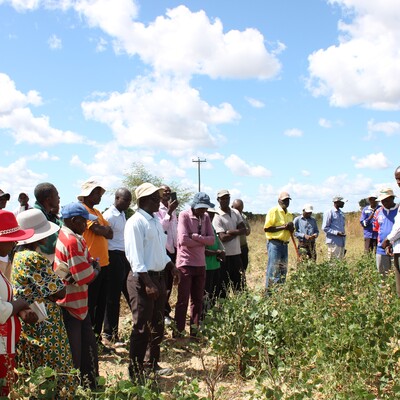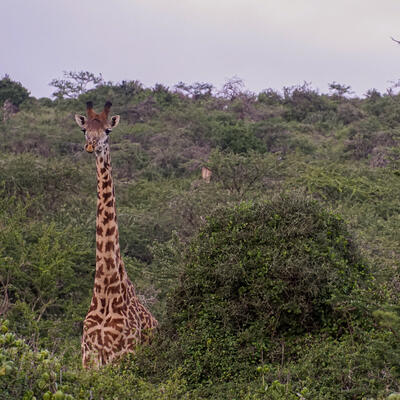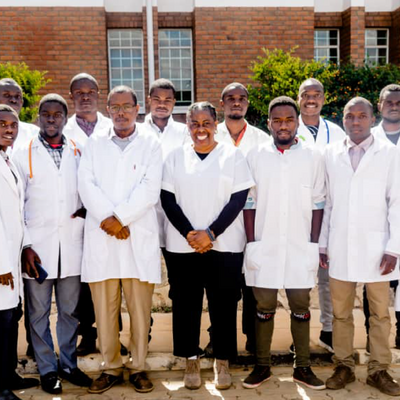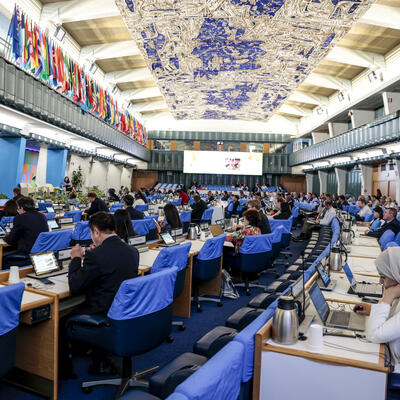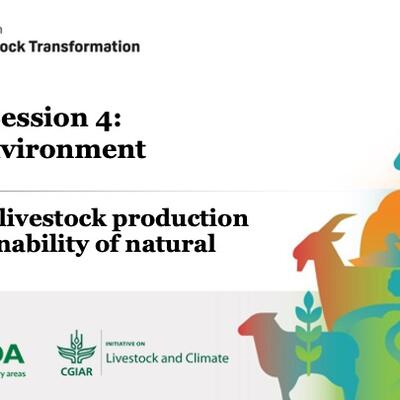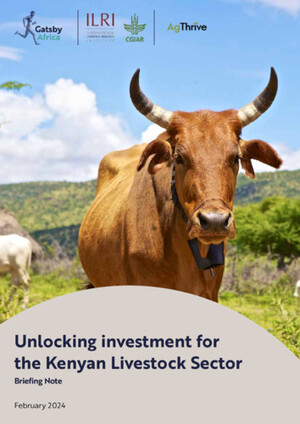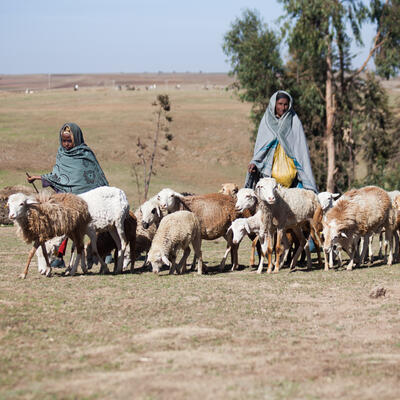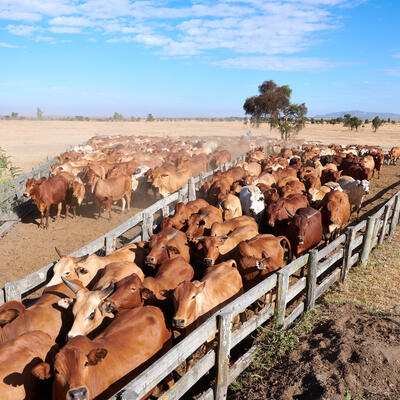

East African drylands: Big lands—big opportunities
Posted on
by
- Susan MacMillan
- Mireille Ferrari
- Robin Reid
- Fiona Flintan
Earlier this year, in addition to launching a first-of-its-kind 'Rangelands Atlas' (see link below), staff of the International Livestock Research Institute (ILRI) produced two films for an ILRI-hosted 'Virtual Tour of East Africa’s Drylands’ session at the recent Global Landscapes Forum on Restoring Africa’s Drylands, 3–4 June 2021.
The first film, aiming to provide an ‘immersive’ African dryland experience for readers, is titled: East African Drylands—Big Lands, Big Opportunities (9:20 min).
This week, this film was selected for another virtual tour, this time for the Joint International Grasslands and International Rangelands Virtual Congress (25–29 Oct 2021).
The facts, ideas, words and science presented in this film—and in this blog article about the film—are taken from the following resources. Readers are recommended to consult these first-rate sources directly.
- Rangelands Atlas
a collaborative project by ILRI, IUCN, FAO, WWF, UNEP and ILC (2021) - Prospects for Livestock-Based Livelihoods in Africa's Drylands
edited by Cees de Haan (World Bank Studies, Washington, DC, 2016) - Dynamics and resilience of rangelands and pastoral peoples around the globe
by Robin Reid, María Fernández-Giménez and Kathleen Galvin
(Annual Review of Environment and Resources, 2014) - Savannas of Our Birth: People, Wildlife, and Change in East Africa
by Robin Reid (University of California Press, 2012) - East African Grasslands
by Desmond Vesey-Fitzgerald (East African Publishing House, 1973)
Maasai have lived in the Masai Mara for nearly 4,000 years. We use the open plains to herd our livestock.
Maasai people respect the Mara because it provides everything our livestock need. We rarely kill wildlife for food.
By living side by side with wild creatures, we believe we look after the land.
Dickson ole Kaelo, CEO, Kenya Wildlife Conservancies Association
PART 1: GLOBAL DRYLANDS
1 The world’s drylands have excited people’s imaginations for generations—for good reason
Drylands cover more of Earth’s land surface than any other type of land and are home to most of the Earth's savannas.
The world’s dry rangelands have variable and often harsh climates, are sparsely populated and remote from markets, are grazed by both livestock and wildlife, and are mostly used and managed in common.
Pastoralists and their livestock herds inhabit the drier parts of rangelands.

Samburu warrior with goat (photo credit: Sandy Bornman).
2 More than most regions, rangelands are susceptible to myth-making
Laments for the demise of pastoralism are themselves part of the historical tradition, but real pastoralists, awkwardly, have refused to die.
Historians Richard Waller and Neal Sobania
Evidence now counters the once-prevalent idea that livestock in African savannas are responsible for vast environmental degradation and desertification.
The facts simply do not support the belief that livestock cause widespread degradation of savannas or, conversely, that there is no need to worry about livestock damaging savannas.
Even though the idea of widespread degradation of savannas has been challenged for decades, it still persists.
In the past, pastoralism was thought to be the root cause of the spread of deserts, especially in Africa. Recent evidence suggests that land degradation is not a widespread phenomenon.
While savanna degradation does occur, savannas are more resilient than we tend to think. The larger concerns are about the loss of savannas altogether to farmland, towns and other uses.
It is difficult to measure degradation well, and thus it is rarely done. And what is judged degradation depends on one’s perspective. A pastoralist might see exclusion of livestock from game parks as degradation of grazing land while a conservationist might consider this useful wildlife habitat.
Overgrazing is a tricky term—difficult to define and value-laden in its interpretation.
It took ten years to understand that it’s not people or animals causing desertification in the Sahel but climate. It took another ten years to understand that it’s not heavy livestock grazing that degrades Sahelian range but permanent rather than periodic grazing over the entire growing season.
In the past, we assumed that most rangelands used in common by herders were overgrazed and degraded. Now we understand that many drier rangelands have nonequilibrium dynamics, where climate has more impact on vegetation than grazing does.
In the past, many scholars thought African pastoralists were irrational and greedy to increase the size of their herds; now, many view periodic herd growth as a sound strategy for coping with recurrent drought. Once, scholars thought that communal grazing damaged rangelands; now, they have come to realize that herders create rules-of-use that in fact sustain rangelands.
3 Africa: The 'savanna continent'
The most common way for people to turn sunlight into food in the African savannas is to herd domesticated animals across commonly owned land to take advantage of changing water and forage resources. The herds transform hard-to-digest plant matter into nutrient-dense, easy-to-digest animal tissue and fluids: meat, milk, and blood. This way of using dryland is known as pastoralism.
Robin Reid, Savannas of Our Birth
Savannas are grass-dominated tropical ecosystems that include some trees and shrubs and have alternating wet and dry seasons.

Riccardo Gangale
Herding camels in Wajir, northern Kenya.
PART 2: EAST AFRICA’S DRY PASTORAL SAVANNAS
4 The exceptionalism of East Africa—'our hominin home’
Remnants of the great Pleistocene herds of wildlife remain most abundant and diverse in the savannas of East Africa, where they have lived side by side with the region's pastoral people for millennia.
Here, as elsewhere, grazing is the most widespread use of the savannas.
Both savannas in East Africa and the pastoral peoples that inhabit them differ from those in the rest of Africa in fundamental ways.
Due to their long history of wildlife grazing and fire, it is plausible that savannas in East Africa were, in a sense, ‘pre-adapted’ to the herders and their stock when they arrived from the north several millennia ago and started grazing their stock and burning the grass.
Rich soils, annual double-wet seasons, and highly varied topography created conditions in East African savannas rarely found elsewhere.
Many East African savannas have two wet seasons and two dry seasons each year rather than just one of each. This pattern is rare both in the rest of Africa and around the world.
This bimodal (two-season) rainfall, with precipitation spread out over each year in two seasons rather than one, keeps grass growing and animals fed almost year round, which in turn keeps livestock producing milk for long periods. This makes pastoralism more viable than crop farming in much of East Africa's savannas. .
East Africa’s pastoral peoples can be split into more than 70 linguistic, social, cultural, and political groups that include the Rendille, Ariaal, Borana, Gabra, Orma, Samburu, Njemps, Kipsigis, Pokot, Nandi, Tugen, Il-Chamus, Teso, Turkana, and Kamba of Kenya; the Maasai of Kenya and Tanzania; the Barabaig, Tatoga, and Parakuyu of Tanzania; the Dinka, Nuer, Shilluk, Toposa, Murle, and Nyangatoum of South Sudan; the Beja, Kababish, and Fulani of Sudan; the Jie, Karamojong, and Bahima of Uganda; the Afar, Borana, Oromo, Mursi, and Daasanach of Ethiopia; the Tutsi of Rwanda and Burundi; and the Somali of Somalia.
A final reason the savannas of East Africa are special is that they are most likely the ‘savannas of our birth’. Our own species, Homo sapiens, evolved here some 200,000 years ago, eventually moving out of Africa and replacing other hominins to become the only Homo on Earth. In this sense, every person can claim East Africa as their ancestral, hominin, home.
Because savannas are part of our deepest evolutionary past, to fully understand our evolution, we must view it in the context of African savannas and their large mammalian fauna.
The Kenya example
For decades, these lands and peoples have been marginalized and seen as unproductive, with news of cattle rustling, drought, insecurity and poverty hiding the great potential of the region.
Both the recurrence and intensity of droughts has increased in Kenya in recent decades, with the country’s arid and semi-arid lands now experiencing droughts, and consequent food deficits, on an almost annual basis.

ILRI/Camille Hanotte
Borana herdsman and cattle in Yabello, Ethiopia.
5 Pastoral and grassland productivity is greater than you know
Farming requires several months of sufficiently high rainfall to support plant growth, whereas herders and their livestock can move to take advantage of patches of green grass and ephemeral water sources to survive dry spells. The flexibility of moving with herds was clearly a better way than farming to access food reliably in East Africa.
Non-pastoralists often accuse pastoralists of irrationally keeping too many livestock. But keeping many animals is a proven survival strategy in Africa's savannas. Those with large herds are left with relatively more animals after drought than those with small herds.
Pastoral grazing sometimes enriches and sometimes degrades savannas. While livestock grazing can diminish productivity in some fragile areas, few cases suggest that this diminishment is permanent. In more resilient savannas, evidence shows that livestock grazing can improve productivity—up to a point.
New evidence in the 1980s indicated that, while ‘equilibrium dynamics’ exist in wetter, climatically more predictable semiarid to humid savannas, the drier and more variable ’nonequilibrium’ arid to semiarid savannas are harder to degrade and show little feedback or coupling between livestock and vegetation.

Luigi Guarino
Masai Mara at sunset.
6 Africa’s dry savannas and pastoral herders are resilient
Given their long evolutionary history supporting grazing animals, East Africa’s savannas appear to be quite resilient to both wildlife and livestock grazing. Here, where soils and plants evolved over millions of years along with wildlife and hominins, the savannas are probably as or more tolerant of grazing and fire than any ecosystem on Earth.
Tropical forest and desert plants have in common a relatively constant (wet or dry) climate, while savanna plants must survive a great variability in growing conditions. A savanna may be lush and green one season, parched and brown the next. Because wet seasons can be short and dry seasons long, savanna plants must respond quickly to rainfall, as must the people and wildlife who depend upon them.
Charles Darwin, recounting his voyage on HMS Beagle, was astonished by the productivity of the savannas of southern Africa:
‘There can be no doubt of its being sterile country . . . covered by a poor and scanty vegetation,’ he wrote. ‘Now if we look to the animals inhabiting these wide plains, we shall find their number extraordinarily great, and their bulk immense . . . . I confess it is truly surprising how such a number of animals can find support in a country producing so little food.’
The answer to Darwin's conundrum is this: savannas can support so many animals because grass that grazers consume regrows quickly and is relatively easy for grazers to digest. A forest, in contrast, while supporting 10 times more plant mass than a savanna, is only 10% as productive. And much more of that plant mass is edible in savannas than in forests.
For millennia, pastoralists have proved brilliant at addressing the challenges of dryland areas, where the ‘balance of nature’ does not exist: rather, disruption, variability and instability are the norm, which pastoralists adapt to through flexible movement, skilled herding and livestock management.
As we confront uncertainties in today’s complex and turbulent world, we could all learn from pastoralists, who continue to navigate uncertainties with deep knowledge and practised skill.
Iain Scoones, Institute of Development Studies, Sussex University

TJ Kakuris
Herd of elephants in Kenya.
7 People, livestock and wildlife have co-existed on East Africa’s savannalands for millennia
Africa alone more or less escaped the massive extinctions of megafauna that occurred in the Pleistocene epoch. Today, only African savannas continue to maintain a startling diversity of large mammals.
Africa is remarkable not because there are many types of mammals but because they are so big. No other place in the world supports the diversity of large mammals that live in Africa today.
In East Africa, people and wildlife co-evolved together. Our hominid ancestors walked alongside wildlife on savannas for millions of years before livestock came to East Africa some 3000–4000 years ago.
Wildlife conservation in savannas without people, a Western cultural notion, does not fit landscapes that were partly created and maintained by people in East Africa over many millennia.
An African conservation ethic for pastoral savannas would be an ethic that promotes conservation-with-development and development-with-conservation.
Outside parks and commercial ranches, most wildlife live where herders continue to move their animals seasonally, where most land is still used in common (although land is privatizing rapidly in some places), where people raise livestock for household needs more than for sale in the market, where fences remain rare, and where people see their landscapes through a ‘livestock lens’.
That wildlife are abundant on pastoral lands is not a coincidence; where wildlife still exist in these landscapes, it is because pastoral people choose not to exterminate them. This is not to deny that cohabitation of wildlife and pastoralists in savannas comes with significant conflicts and costs for both.
A central irony in this story is that the peoples who, amid tremendous change, still coexist with wildlife are those most often held responsible for overgrazing, spreading deserts, and being generally poor environmental managers.
Conservation of wildlife, while good for the globe, should also be good for the local neighborhood. But although pastoral people are, of course, part of dryland ecosystems, it remains rare for pastoral communities to have any say in what goes on in nationally managed parks and reserves.
Separating people and wildlife by way of wildlife parks may be not only socially unjust but also ecologically unsound. Conservation of a wide range of species may best be done by interspersing protected areas within larger, actively used pastoral landscapes. This ‘parks and people’ model is new, only recently embraced by proponents of both conservation and pastoral development.
It appears that there are synergies between people, livestock and wildlife at low human and settlement population densities. When livestock populations are low to moderate, they sometimes can diversify plant communities and improve energy and nutrient flows to other grazers. Other evidence suggests that mixed livestock-wildlife systems are more diverse and productive than systems with either livestock or wildlife alone.
When farms cover a major part of a savanna, most wildlife disappear. To grow crops in a savanna with abundant wildlife requires access to enough water to grow a crop to maturity and protection of that crop from wildlife. The few studies available suggest that wildlife start to disappear when farms and settlements cover 25–50% of savanna landscapes. Research also suggests that wildlife numbers begin to decline when human populations reach 8–10 people per km2; about 90% of wildlife disappear when there are more than 75 people per km2.
Where pastoralists share fairly in the profits stemming from wildlife conservation, conflicts can be turned back into coexistence. Humans and wildlife can coexist through the creation of community-bed conservancies—privately protected areas that engage local people in conservation and ecotourism. These conservancies, which can help stem the unrelenting losses of mammalian biodiversity, are spreading across Kenya, where more than 200 have now been established.
8 Pastoral survival strategies are to stay socially connected, mobile and flexible
One at a time, the ‘evil three’—drought, disease, insecurity—can make life for pastoral families difficult. But when they come all at once, devastation can result.
Pastoral herders have no choice but to move, more often in the drier savannas, where the rainfall is particularly patchy.
Most pastoralists agree that their most important survival strategy lies in the complex web of social connections and mutual obligations that form their social safety net, the glue of herding societies. Social ties and safety nets, usually created or strengthened by an exchange of livestock, are particularly important to those who live in the driest and riskiest environments.

Joana Roque De Pinho
Maasai pastoral scene.
PART 3: BIG SAVANNAS IN BIG TRANSITION
9 Africa’s dry savannas are in trouble
The great grasslands of East Africa—cradle of humankind, nomadic ways of life with cattle; last refuge for the largest, most diverse concentrations of big wild mammals on earth; the ‘jewel’ of the grand plains game of East Africa—are in trouble.
The size, productivity and biodiversity of these grasslands are all in decline.
Well-intended development efforts, such as the introduction of techniques from wetter farming lands into drylands, can inadvertently make pastoral families more vulnerable.
Changing land tenure arrangements, lasses-faire land-use policies, and increasing human population and agricultural demands are driving people onto rangelands. Open savannas are becoming increasingly bounded and fragmented. Fragments of range are becoming stranded among constructs of permanent human settlement—wheat fields, maize plots, fences, roads. The land stops functioning as range, wildlife die off, and pastoral ways of life disappear.
Savannas are in trouble today because changes are coming too fast for plants and animals, including people, to adapt to those changes.
Like herders elsewhere, pastoral families in East Africa today are generally less nomadic than they were a century ago, or even a decade ago, in part due to governmental programs that are replacing communal property rights with individual land ownership.
In many places, the herding lifestyle is simply less economically viable than it used to be. The chief reason is that there are so many more mouths to feed from the same, or a shrinking, land base. Most pastoral families find that while livestock are still the cornerstone of their livelihoods, they must add other sources of income—farming, business, teaching—to be able to feed their families and meet growing cash needs.
Pastoral people want the same societal goods and services that people in places with higher rainfall want: good health care for their families and their livestock, good schools for their children, good markets for selling their livestock, and new technologies such as mobile phones and faster transportation.
Many children from pastoral families now have access to formal education, a rarity only a generation ago. Families are changing how they produce food, what they eat, what they wear, and how they aspire to live their lives.

ILRI/Dave Elsworth
The savanna grasslands of East Africa.
10 Pastoral drylands and peoples are undergoing big changes
Africa’s rangelands are in big transition.
Pastoral people and savannas are now facing many challenges: climate change, globalization, growing human populations and migration, demands of growing economies, changes in land use and tenure, new technologies, new policies on conservation.
These new and accelerating political, economic, and climatic stresses are challenging pastoral resilience and ability to adapt.
We have increasingly evidence in East Africa of situations where the possible synergies between people and wildlife breakdown.
Future warming may make the climate more variable, with wetter wet periods and drier dry periods. The climate will also be less predictable as it warms.
11 Pastoral responses to change are further adaptations
In response to these changes, pastoralists are creating new ways to manage rangelands.
In Kenya, pastoralists are collaborating across newly privatized lands, creating institutions such as conservancies and grazing associations to unify the fragmented landscape. Community-based rangeland management remains one of the most promising alternatives for achieving socially just, economically viable, and environmentally sustainable management of rangelands and the biodiversity they support.
Recent learning and experimentation with both community- and market-based institutions are moving us closer to achieving socially just, economically viable, and environmentally sustainable management of rangelands and the biodiversity they support.
Challenges remain, particularly how to ensure that new institutions share benefits equitably, how to manage and monitor spatially extensive systems that often require herd mobility across scales, and how to determine the environmental returns of investing in conservation stewardship practices.
Our species rose to dominate the Earth in part because of skills we learned long ago in savannas.
Today, savanna environments and savanna peoples hold genetic, behavioral, and cultural information that point to new ways for humanity to continue to adapt.
Robin Reid, Savannas of Our Birth

US Air Force Photo/Tech Sgt Daniel St Pierre
Boy herding cattle in Daaba, Kenya.
12 The future of Africa’s pastoral drylands
In the vast majority of savannas, land use still occupies the middle ground, with people, livestock, and wildlife continuing to mix.
There exist elusive but practical win-win situations that can help local people to meet their changing aspirations and needs while conserving the wildlife around them—and further, that it is in the self-interest of all nations that this happens.
While historically most of the benefits from wildlife flowed outside savannas to the state while all the costs were borne by local communities, this is now changing. The people who live with the costs of wildlife must capture a larger share of the benefits of wildlife than they do today.
Pastoral communities need secure access to land and its resources, with ancestral rights to land honoured.
Policymakers should embrace the following:
- pastoral land is productively used (it is neither empty nor wasteland)
- livestock grazing is generally more sustainable than farming in Africa’s savannas
- sustainable livestock and pasture production relies on pastoral mobility
- pastoral communities know how to manage savanna ecosystems and wildlife
- common land ownership is a legitimate and appropriate way to approach land use
Some 30 years ago, saving the last rainforests of South America from the axe of development caught the imagination of the world. As our understanding grew, so did our commitment to protect the indigenous peoples as well as biodiversity of the rainforests.
The great savannalands of eastern Africa—cradle of humankind, home to traditional nomadic pastoralists, and last refuge of some of the most spectacular wildlife populations on earth—can, and should, draw similar levels of global commitment.

Martin Sharman
You may also like
Related Publications

Food Safety Technical Working Group in Vietnam E-bulletin, July-December 2024
- Food Safety Technical Working Group in Vietnam

Context Matters: Tackling Methane in Livestock Systems for a Sustainable Future
- Food Systems for the Future (FSF)
- Environmental Defense Fund
- International Livestock Research Institute

One Health scientific conference: International practices and lessons learned for Vietnam
- Vietnam One Health Partnership
- International Livestock Research Institute
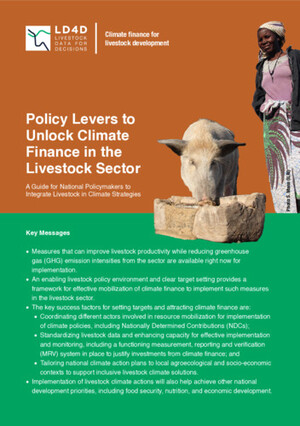
Policy levers to unlock climate finance in the livestock sector: A guide for national policymakers to integrate livestock in climate strategies
- Alemayehu, Sintayehu
- Cramer, Laura
- Gonzalez Quintero, Ricardo
- Kimoro, Bernard
- Kohler, Gregory
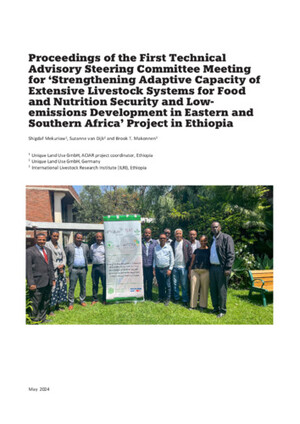
Proceedings of the First Technical Advisory Steering Committee Meeting for ‘Strengthening Adaptive Capacity of Extensive Livestock Systems for Food and Nutrition Security and Low-emissions Development in Eastern and Southern Africa’ Project in Ethiopia
- Mekuriaw, Shigdaf
- Dijk, Suzanne van
- Makonnen, Brook T.





